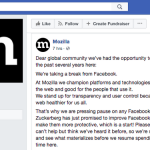Facebook Has Serious Transparency Issues, But Advertisers Aren’t Going Anywhere
It’s been a big week for Facebook advertising. And I don’t just mean how it accounts for 77% of the digital ad industry’s overall growth last year. Or the way it shares near complete dominance of the category with Google. That stuff, as the waves of promoted posts in your feeds will tell you, is pretty typical.
No, this week the social network got hit with a trifecta of bad news on the advertising front. First was P&G CMO Marc Pritchard demanding, via an Adweek cover story, more transparency–which holds a lot of sway given he’s got a $2.4 billion annual U.S. advertising budget. Then we learned that roughly 3,000 ads from Russian sources were sold on the platform during the last election cycle, and they featured polarizing content about presidential nominees and hot-button issues. And finally, an analyst looked at census data and discovered that Facebook has been inflating its ad reach numbers in the U.S. by more than 10 million in some age ranges.
All of these have something in common: They illustrate just how little we know about how Facebook’s ad ecosystem works. Despite all the new metrics, glitzy dashboards, and custom targeting options, for many skeptics this proved that John Wanamaker’s old advertising adage still holds true. (He famously said that, “Half the money I spend on advertising is wasted; the trouble is I don’t know which half.”)
But is it all really that big of a deal?

Media agency execs I spoke to this week downplayed the numbers game. Whether it’s 41 million 18-24 year-olds or 31 million, that’s still a helluva lot of 18-24 year-olds. Besides, as PHD USA’s chief investment officer Craig Atkinson told me, his clients are much more interested in using Facebook for its sophisticated audience targeting capabilities than finding audiences based on age, gender, and demography. “Our clients are looking for allergy sufferers, vacation intenders, movie enthusiasts, and people with a car about to come off lease,” said Atkinson. “Once that level of precision is available, exactly how many 18-34-year-old females that exist in the U.S. is a much less interesting number. That’s where the true power of Facebook lies.”
That may be so, but now people like P&G’s Pritchard and Unilever’s CMO Keith Weed are publicly calling for more metric transparency, and Sen. Mark Warner (D-VA), the co-chair of the Senate committee investigating Russia’s influence on the election and possible links with the Trump campaign, wants to see Facebook at a public hearing about its role. Expect the social network to be increasingly proactive in rolling out more features and reporting numbers to help assuage them.
Facebook, for its part, is trying to stay ahead of all this. When I reached out for a comment to include in this article, they admitted that their advertising tools are for estimates and campaign planning only. “It’s not a business’s actual reach or campaign reporting, and is not billable,” they said in a statement. This helps explain the discrepancy between its audience estimates and the U.S. census. And, to its credit, Facebook did release new tools earlier this year that offer increased transparency to advertisers, particularly around where their ads would appear.
One has 2 billion users, the others have billions of dollars to spend, and the metric transparency tug of war between Facebook and its advertisers is far from over.
(33)











